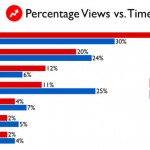BuzzFeed’s Quest For impression within the Viral information technology
When BuzzFeed CEO and founder Jonah Peretti introduced the corporate’s distributed publishing technique just about a 12 months in the past, it used to be accompanied with the aid of a brand new metric with which to measure BuzzFeed‘s reach throughout more than one systems. just a few weeks later, BuzzFeed announced it had surpassed 5 billion “content views.” In a post ultimate week, writer Dao Nguyen published that point spent and engagement at the moment are equally important ways in which her staff measures the success of their content across the globe.
but toward the end of my reporting for this month’s characteristic story about BuzzFeed, Peretti mentioned another way to measure content material, one that I had not heard him discuss up to now: impact.
“What issues most, and what all these metrics must attempt to level to is influence,” Peretti said all over a presentation at NYU’s Stern industry college. “Does it have an impact on individuals’s exact lives, are people the usage of the content material, is it something that issues to them? we’ve been thinking so much about how do we measure affect.”
“we do not see ourselves as producing artworks to hang on the wall,” editor-in-chief Ben Smith advised me. “we predict a lot more about what a bit of media does.”
whereas it should have once been fashionable to put in writing BuzzFeed off as a house for quizzes and cat videos, these days there’s no denying that its news group is having an impression. earlier this month, the American Society of journal Editors awarded BuzzFeed a prestigious Ellie award for a sequence on the abuse of international visitor staff titled “the new American Slavery.” The investigative staff has uncovered ghosts colleges in Afghanistan paid for with American tax dollars, as well as alleged sexual assaults in German refugee camps.
In so much the same manner that CNN used to be mocked for years sooner than turning into the defining news group of a era, BuzzFeed is fast changing into a respected outlet for severe journalism. Janine Gibson, former editor-in-chief of The Guardian‘s web page, now runs the U.ok. information workforce. The 400-person news group of workers comprises two Pulitzer Prize winners, along with 16 world correspondents based totally in 12 completely different countries (by means of comparison, Jeff Bezos’s Washington submit has 21 correspondents in thirteen nations).
BuzzFeed‘s news division has now not been with out controversy. One politics editor was once fired in 2014 after it used to be discovered that forty one of his articles incorporated unattributed writing by using people. And this past April, Smith exact three cases wherein posts were deleted from the web page as a result of they said negative things about BuzzFeed advertisers.
in contrast to the articles on different parts of BuzzFeed, you normally will not see any highlighter-yellow circles with OMG in the midst of a information article. but every now and then a “Trending” field seems that displays the selection of views the information put up has attracted. As with other components of BuzzFeed, there’s an emphasis on growth inside news.
“We’re among the publishers that need to have an enormous target audience,” Smith says, “and we’re unashamed about that.”
Smith says that “information is a meaningful proportion of the general website online traffic,” even supposing he would now not specify how a lot.
It underscores some of the conundrums faced by BuzzFeed, along with many other media firms within the digital age: How do you balance the industrial crucial of getting an enormous audience with the will to provide high quality information tales that might most effective be related to a small staff of individuals? A series on the makes an attempt by way of four states to illegally purchase execution medicine from India isn’t reliably going to fetch the number of clicks required to build a globally disbursed media company. but that reporting did get demise row executions halted in Nebraska for a while.
if you happen to expertise a cognitive dissonance while you see a promotion for the This Week in Cats newsletter on the bottom of a piece of writing about loss of life penalty medicine, as I did not too long ago, it would not faze Mark Schoofs, the Pulitzer Prize-successful former Wall side road Journal writer and ProPublica editor who leads BuzzFeed‘s investigative journalism group. I requested him outright whether or not he concept BuzzFeed used to be merely buying respectability with a view to continue getting cash off of humorous lists and movies.
He says that while it is going to were a fair question when he joined the company in 2013, the commitment is now simple—and that its demonstrated by means of the scale of his reporting crew. “I imply, they promised me six individuals. now we have 19. If it was once just a hood decoration, possibly you cease at eight,” Schoofs says.
When requested about what the corporate’s expectations have been in regards to deliverables and frequency, Schoofs insists that the mandate is solely to “do great work.” at the comparable time, he admits to being keenly privy to all the metrics—”the whole thing that happens on account of a BuzzFeed story.”
Criticism of BuzzFeed‘s editorial ambitions incessantly imply that news tales, via definition, is not going to have the same attain as a lovable cat video. both Schoofs and Smith consider that is a false dichotomy.
“regularly the stories with the most important affect even have the most important target market,” says Smith. for example, a latest bundle exposing worldwide tennis fit fixing received roughly 1.5 million views.
the hassle to draw a much wider target audience is reflected in the way BuzzFeed is trying to inform extra critical stories. one of the most stories in their series on the abuse of H-2 visa employees starts with an anecdote a few double date. “I mean, you are expecting it first of all some sob story about a worker within the fields of California within the baking sun, and it begins with a double date,” says Schoofs. “it is this sort of cinematic opening, and that’s the reason completely different from quite a few investigative reporting.”
it’s no longer the standard consume-your-broccoli journalism. “I hated that. It was once like fingernails on a chalkboard, and i didn’t need to redo that. So, we are attempting, and once more, i am now not looking to say we at all times be triumphant, however we actually try to make our tales work,” he says. “We do most certainly have a predilection for stories that have real, authentic victims.”
that is the key hyperlink between BuzzFeed‘s sequence on battered women who get wrongly convicted of crimes, or the Texas cities which can be sending bad folks to penitentiary over site visitors fines. “All these tales have clear victims, and people victims are powerless.”
Which brings us back to impact: How do you measure it? Peretti has a number of ideas, and he poses them as a sequence of questions.
Does the editorial asset work throughout platforms?
A video that turns into fashionable on facebook may not be a hit on Snapchat. but when it racks up numerous views in each locations, then there’s a high probability that it’ll translate successfully nearly in every single place.
Does it click internationally?
A recipe for 3-ingredient Nutella truffles that was once a success in the U.S. used to be quickly translated into 5 totally different languages, and it has got over seventy eight million views on facebook alone.
Does it lend a hand folks connect with each and every different?
The “bizarre issues that all Couples fight About” video, which has 5 million YouTube performs, used to be “not an excellent video,” admits Peretti, “but an excellent video to speak about your relationship.” For proof, read probably the most nearly a hundred and fifty,000 comments accompanying the video on fb, a lot of which title-check the person they’re in a relationship with.
Does it lend a hand individuals make stronger their lives?
an article titled “29 belongings you by no means Knew About Nipples” led one BuzzFeed reader to visit the doctor and have her breast examined. She had stage 1 breast cancer, and it was caught prior to spreading additional.
Does it inform the public and alter institutions?
When BuzzFeed found out that Nebraska’s death row used to be importing doubtlessly shady execution medicine from India, the governor stepped in and halted capital punishment across the state.
Does it make the world extra open and diverse?
every other spherical, BuzzFeed‘s weekly podcast about racism, sexism, and whatever else hosts Heben Nigatu and Tracy Clayton really feel like talking about, lately had democratic presidential entrance-runner Hillary Clinton as a guest. They pointed out uncomfortably familiar plot traces from the CBS show “the great wife,” and requested Clinton arguably probably the most pointed, substantive query she’s ever received: Did the mass incarceration policies passed throughout her husband’s administration “really fuck [things] up for black individuals” in the U.S.?
on the end of the day, whether it is a listicle or a investigative reporting bundle, reaching real impression comes right down to coming up with one thing new. “these things is artwork and science,” says Smith. “one of the issues about information is that writers are following the tales and unearthing issues no person knew. and also you don’t come up with a shocking revelation by means of having a look at what folks already know and are already considering.”
(26)














